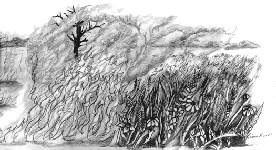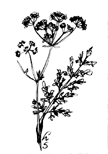Greenacres Links
Landscaping Resources
- Weedlaws
- Toolkit
- Native Vegetation Enhancement
- Wild Ones Handbook
- Homeowners' Resources
- Landscaping Naturally (video)
Remember, we will not post any information intended to directly benefit for-profit enterprises
 Green
Landscaping: Greenacres
Green
Landscaping: Greenacres
Wild Ones Handbook
WHAT EVERY WILD ONE SHOULD KNOW
- How to Naturally Landscape Without Aggravating Neighbors and Village Officials
- Important Causes of Hayfever
- Observational Design
- References
- It Starts With The Soil
- Removing Vegetation
- Handling Wild Seed
- Buying Seed: Pretty Packages No Substitute For Patience and Local Seeds
- Planting A Prairie
- Prairie Maintenance
- Planting A Woodland
- Creating A Water Garden
- Landscaping For Wildlife
- Wood Projects
- Planting Policies
- Aggressive Species
|
"Once we become interested in the progress
of plants in our care, their development becomes a part of the
rhythm of our own lives and we are refreshed by it.-
Thallasa Cruso
|
Prairie Maintenance
by Alan Wade, Prairie Moon Nursery
MOWING
Mowing is the primary management tool used to prevent weeds from
shading prairie seedlings. During the first growing season the
planting may need mowing a number of times. The cutting height should
be 4 to 5 inches (a home lawnmower set at the highest cutting position
should work well for small areas). Mow each time the weed growth is 6
to 10 inches high and do not allow weeds to set seed. Do not worry
about cutting the tops off or crushing the seedlings. A flail-type
mower is preferable for large areas because it chops cuttings into
small pieces which will filter down and serve as mulch. If a
sickle-bar or rotary-type mower is used, mow more frequently so
cuttings will not have become large enough to smother native
seedlings. Try to time the last mowing so weeds can grow to about 8
inches before winter. This will help protect young seedlings from
heaving frosts. During the second growing season one mowing may be
helpful in late spring or early summer if weeds are thick. This should
be the last mowing needed for weed control unless a serious problem
occurs. Raise cutting height to 6 to 12 inches if mowing during second
year.
HAND WEEDING
Hand weeding small plantings during the second and third growing
seasons will make a big difference in your planted prairie. Care must
be used when weeding to avoid disruption of the soil which can
dislodge prairie seedlings. Weeds will generally pull easier a day or
two after rain or watering (when soil is soft but not muddy). Another
control option is to clip weeds near the ground with pruning shears.
Whatever method you use, be sure to remove weeds from the site before
they mature and spread seed. Discriminating between prairie seedlings
and weeds is of utmost importance. If you are unsure as to what your
young prairie plants will look like, plant a small amount of the seed
mix 1/4 inch deep in a regular garden flat filled with sterile potting
soil and keep moist. By studying the seedlings which emerge you will
learn to recognize prairie seedlings. These may then be transplanted
to pots and eventually set out in the planting. An easier method to
avoid pulling prairie seedlings is to remove only plants which you are
sure are weeds. To help identify weeds, cover part of the planting
area with a piece of bed sheet before sowing. Mark the outside corners
of the sheet (stakes, driven in flush with the soil surface, will not
interfere with later mowing). Remove sheet after seed is planted.
Plants that germinate in this marked area can be considered weeds
since prairie seed has been excluded.
BURNING
After two growing seasons, planted prairies need to be burned
annually for the next several years to become well established (mature
prairies with no serious weed problems may need burning only once
every two to four years). Always use caution when burning. Check local
fire regulations and obtain permits. Try to burn or mow only one-third
of the prairie area each year to preserve over-wintering insects,
their eggs and pupae. Always plan fire safety into plantings, even if
you are not going to use burn management. Prairie fires intentionally
or accidentally set during fall or spring dormancy can burn very
rapidly. Use any existing features such as roads, driveways, streams,
lakes, or mowed lawns as fire
 breaks. In addition to paths through a prairie, also include a wide
path around the perimeter. A mowed lawn buffer 20 feet in width
between buildings and prairie is advised. An alternative to burning is
to mow in late fall after seeds set or preferably in early spring
(late March to mid-April). Sites that are too wet in spring need fall
mowing when soil is dry. If burning does not occur periodically,
cuttings need to be removed to avoid a thatch layer buildup. Do not
cut and then burn large quantities of plant material (creating thick
piles) or you will sterlize the soil beneath.
breaks. In addition to paths through a prairie, also include a wide
path around the perimeter. A mowed lawn buffer 20 feet in width
between buildings and prairie is advised. An alternative to burning is
to mow in late fall after seeds set or preferably in early spring
(late March to mid-April). Sites that are too wet in spring need fall
mowing when soil is dry. If burning does not occur periodically,
cuttings need to be removed to avoid a thatch layer buildup. Do not
cut and then burn large quantities of plant material (creating thick
piles) or you will sterlize the soil beneath.
For more information, we recommend purchasing the booklet How to Manage Small Prairie Fires by Wayne R. Pauly.
![[logo] US EPA](../gif/logo_epaseal.gif)
